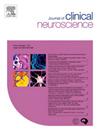Awake craniotomy vs general anesthesia for brain metastases in eloquent areas: neurological and survival outcomes
IF 1.8
4区 医学
Q3 CLINICAL NEUROLOGY
引用次数: 0
Abstract
Brain metastases (BMs) occur in 10–20 % of cancer patients and significantly impact mortality in adults. While awake craniotomy (AC) is established as safe for primary brain tumors in eloquent areas, evidence for its use in BMs remains limited. This study evaluates AC versus general anesthesia (GA) for surgical resection of BMs in eloquent brain regions. This retrospective cohort study analyzed 77 patients who underwent surgical resection of BMs at Soroka University Medical Center between 2015–2022. Patients were divided into AC (n = 16) and GA (n = 61) groups. A secondary analysis examined outcomes across three groups: AC, GA with neuromonitoring (n = 21), and GA without neuromonitoring (n = 40). Primary outcomes included postoperative neurological status, overall survival, and hospital length of stay (LOS). The AC group demonstrated significantly better neurological improvement rates at 14 days (93.8 % vs 21.3 %, p < 0.001) and six weeks post-surgery (56.3 % vs 1.6 %, p < 0.001) compared to the GA group. Mean LOS was shorter in the AC group (4.25 vs 7.18 days, p = 0.072), with lower mortality rates (62.5 % vs 83.6 %, p = 0.085). In the three-group analysis, AC showed superior neurological outcomes, with improvement rates at six weeks being 56.3 % for AC, 4.8 % for GA with neuromonitoring, and 0 % for GA without neuromonitoring (p < 0.001). Awake craniotomy demonstrates superior outcomes for resecting BMs in eloquent areas, with significantly better neurological recovery and trends toward shorter LOS and lower mortality. Neuromonitoring improves surgical outcomes, particularly in GA cases. These findings support AC as a preferred approach for appropriately selected patients with BMs in eloquent regions.
清醒开颅与全身麻醉治疗雄辩区脑转移:神经学和生存结果
脑转移(BMs)发生在10 - 20%的癌症患者中,并显著影响成人死亡率。虽然清醒开颅术(AC)被认为是治疗原发性脑肿瘤的安全方法,但其用于脑转移的证据仍然有限。本研究评估了AC与全身麻醉(GA)在脑区脑转移手术切除中的作用。这项回顾性队列研究分析了2015-2022年间在索罗卡大学医学中心接受脑转移手术切除的77例患者。患者分为AC组(n = 16)和GA组(n = 61)。二次分析检查了三组的结果:AC、GA加神经监测(n = 21)和GA不加神经监测(n = 40)。主要结局包括术后神经系统状态、总生存期和住院时间(LOS)。AC组在第14天表现出明显更好的神经系统改善率(93.8% vs 21.3%, p <;0.001)和术后6周(56.3% vs 1.6%, p <;0.001),与GA组相比。AC组的平均生存时间较短(4.25天vs 7.18天,p = 0.072),死亡率较低(62.5% vs 83.6%, p = 0.085)。在三组分析中,AC显示出优越的神经预后,6周时AC的改善率为56.3%,有神经监测的GA为4.8%,没有神经监测的GA为0% (p <;0.001)。清醒开颅术在切除脑转移区方面显示出优越的结果,具有明显更好的神经恢复和更短的LOS和更低的死亡率。神经监测可改善手术结果,特别是GA病例。这些发现支持在雄辩区适当选择脑转移患者的首选方法是交流电。
本文章由计算机程序翻译,如有差异,请以英文原文为准。
求助全文
约1分钟内获得全文
求助全文
来源期刊

Journal of Clinical Neuroscience
医学-临床神经学
CiteScore
4.50
自引率
0.00%
发文量
402
审稿时长
40 days
期刊介绍:
This International journal, Journal of Clinical Neuroscience, publishes articles on clinical neurosurgery and neurology and the related neurosciences such as neuro-pathology, neuro-radiology, neuro-ophthalmology and neuro-physiology.
The journal has a broad International perspective, and emphasises the advances occurring in Asia, the Pacific Rim region, Europe and North America. The Journal acts as a focus for publication of major clinical and laboratory research, as well as publishing solicited manuscripts on specific subjects from experts, case reports and other information of interest to clinicians working in the clinical neurosciences.
 求助内容:
求助内容: 应助结果提醒方式:
应助结果提醒方式:


